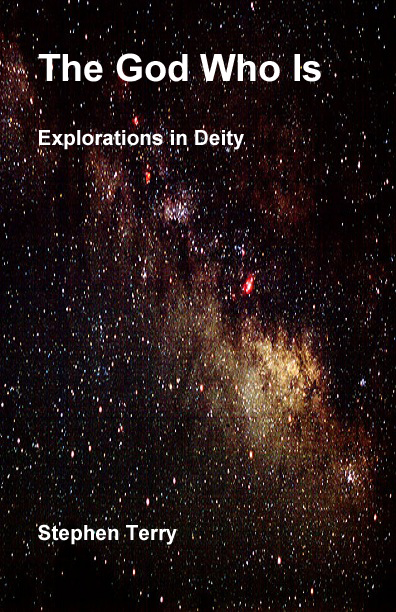Symbolic
Acts
Stephen
Terry
Commentary
for the November 7, 2015 Sabbath School Lesson
 “In
the past God spoke to our ancestors through the prophets at many times and in
various ways, but in these last days he has spoken to us by his Son, whom he
appointed heir of all things, and through whom also he made the universe.”
Hebrews 1:1-2, NIV
“In
the past God spoke to our ancestors through the prophets at many times and in
various ways, but in these last days he has spoken to us by his Son, whom he
appointed heir of all things, and through whom also he made the universe.”
Hebrews 1:1-2, NIV
Perhaps you remember with me those days of long ago when
in kindergarten, the teacher would encourage our artistic leanings by seating
us at a low table and plop in front of us a formless blob of modeling clay. It
may have started out grey, green, blue, or red, but through the kneading of many
tiny hands and the addition of bits of color from other similar blobs the
current color had become amorphous. Like many children faced with no clue from
either the shape or color, when asked to “make something,” we gravitated toward
snakes. Rolling long, cylindrical shapes with bits of clay torn from the mother
mass, we would taper each end to make it “snaky.” If we felt particularly artistic,
we might have rolled a pair of tiny little eyeballs for the serpents. While there
might be a gifted student that would make a Pokey-shaped horse, we were proud
of our snakes and thought we had created masterpieces.
Maybe God feels the same way, or maybe He just started
simple, but He made over three thousand different species of snakes.[i] All are carnivorous but
only a few are poisonous to man to any serious degree. As a young boy on my
great-grandmother’s farm on the western side of the Puget Sound, I would wander
her fields with my siblings and sometimes come upon piles of harmless Garter
Snakes lying on rocks or boards, warming themselves in the sun. Being cold-blooded
reptiles, they needed this to get their morning going as coffee does for so
many of us. With a budding interest in biology, we would peel snakes off the
pile and study their reactions. After a while, they learned to recognize our
approach and would slither off into various cracks and crevices so we could not
catch them unless we were extremely fast. But even watching the piles of snakes
disappear into nothingness was magical and entertaining to small children.
We did not feel threatened by the snakes. They were
harmless, and we already had a nascent understanding of man’s place in the world
of nature. Although we meant no harm to the snakes, we knew also we could do
what we wished with them, and they could not resist us. It was the same with
those clay snakes, we could mold them back into the original lump of clay and
either make something else, or make more snakes like the first one. If we liked
the results, we would be more likely to make more of the same. If not, we would
reintegrate the project and make something different. We understand this as
simple children, yet we struggle to accept the concept as adults when it comes
to God. If we recognize Him as our Creator, that implies a certain power over
what He has created. But if we do not want to recognize that power, we can deny
that He is Creator. Of course, if He is, then this makes about as much sense as
my clay snakes or even the Garter Snakes denying my existence. They can go
about pretending all they want, but reality will demonstrate otherwise. Their
only accomplishment would be self-deception.
We have become quite good at such self-deception. In
spite of many accounts from the past of direct encounters with such a Creator
God, we deny the reality of the existence of such a Being. We pride ourselves
on our “superior” knowledge and relegate belief in such beings to the realm of
childhood fairy tales or women’s superstitions. However, the intuition of those
women may be more in tune with the idea of a Creator than we realize. Many
churches are populated more by women than men, women who continue to bring
those children week after week to hear those “fairy tales.” This is, in some
ways, ironic, for the biblical record indicates it was a woman who first
approached the Tree of the Knowledge of Good and Evil in the Garden of Eden.[ii] Yet it often appears that
women are more eager to return to that lost idyll than men. Strangely, in spite
of this, they tend to be excluded from leadership of those same churches. Maybe
it was not always so that men were so out of tune spiritually.
In the early accounts, it was Enoch that walked so
closely with God that he eventually walked right into heaven.[iii] And Noah alone was found
faithful in the entire Earth.[iv] But what is notable about
these examples is that they are given as contrasts to the prevailing wickedness
of their times. It appears that even then, the person who remained faithful in
his or her belief in God was a rarity. Of course, this is difficult to
understand if all the non-believers of Noah’s day were descended from two
individuals actually created by God, and later, were all descended from
faithful Noah. How could things go so awry? Some might think it is because God
is disengaged with mankind. But if that is an excuse, how do we explain the
wickedness that arose anyway, when, according to the biblical account, God
flooded the Earth to eliminate wickedness. That engagement does not seem to
have prevented the resurgence of evil. What more could God have done?
Maybe some feel He should come down and live with us.
But He did that, and we crucified Him. Maybe if he raised someone from the dead,
it would make a difference. He did that, too, and we plotted to kill that person,
Lazarus, as well.[v]
Over and over, He tried to reach us, often through tears, but we killed and
mistreated the messengers. Through symbolism, they portrayed the relationship
between the Creator and His creation. As Jeremiah pointed out with the illustration
of the potter sitting at his wheel and forming something from the clay taken
from the ground,[vi]
God also lovingly formed those first humans we know as Adam and Eve.[vii]
The potter at his wheel has the right to form any shape
he wishes according to his ability. He may make a beautiful and elegant vase, a
simple but useful oil lamp, or a porcelain bedpan. It is the potter who determines
the form and thus the function of his creation. But what if the bedpan decides
it wants to be a vase instead? To do so it would have to live in defiance of the
purpose of the potter, who intended it to be a bedpan. Even when we may see
bedpans holding flowers in water, no one doubts that it is still a bedpan and
not an elegant vase. No amount of repurposing can change that. This is so even
if the bedpan starts calling itself a vase and states the potter intended it to
be one.
How often do we deny our Creator, believing He Created
us to be something other than what we are? Like some, we may believe that even
though we are obviously male, we are really female or vice versa. Then we go to
great lengths, including surgery, to make our belief real. Or as some others may
believe, even though we are created with the biology for procreation, somehow
it was not intended for that purpose, and same-sex relationships were what the
Potter intended in spite of the structure of our bodies. Then there are still
others who believe that the womb was never intended by the Creator to be a safe
place to bring new life into the world, but was instead to be invaded at will
in order to bring those nascent beings to a violent end. While these destroy
the image of God before birth, too many also do so after the child is born.
Some willingly bring disease, disability and death to others as byproducts of
their quest for profit. Sadly, for some there is not even this much of a reason
to destroy God’s creatures. For those who have the power and the inkling, the
simple desire to end the life of their fellow man or any other creature is adequate
reason to do so.
Perhaps in such destructive behavior is manifest the
less obvious intent to not only destroy that which God has created, but in so
doing to deny Him as Creator and the One who is able to define our purpose.
When we do this, who is left to define that purpose? Do we define it ourselves,
or is it instead thrust upon us by those lesser self-stylized deities who rule
our planet in the interests of their own personal power and greed? And why
would we think that such would never lead us astray, believing that they have
only the truth and our best interests at heart? Perhaps it is time we consider
the purposes of the Potter and return to that which we were created to be. He
has been calling to us since the beginning.
